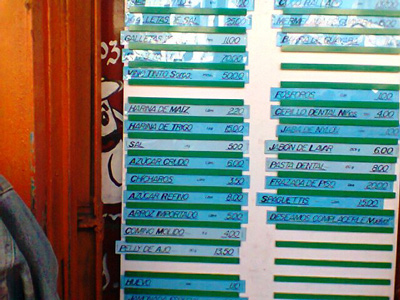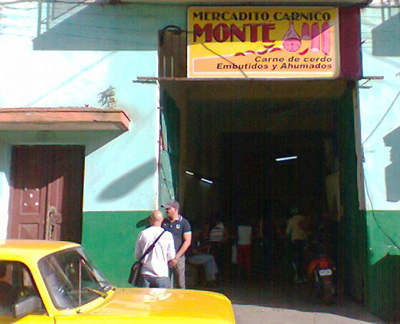Finding our Bearings in the Stormy Seas of Cuba’s Food Market (I)
“What will happen now? Bah! Thorny negotiations and harmless shoot-outs and, afterwards, everything will be the same, even though everything will have changed.” (El Gatopardo, 1957)
Vicente Morín Aguado

HAVANA TIMES – Figures for Cuba’s food industry and market continue to point upwards. The longed-for drop in prices is still nowhere to be seen six years after the “reform” of agriculture was undertaken, when President Raul Castro entered office.
Making sense of the jig-saw puzzle assembled over fifty years of improvisations demands patience. We must first describe the six basic components of Cuba’s veritable economic Frankenstein:
- The Rationed State Market (MRE): a basic quota of food products sold at subsidized prices in Cuban pesos, a residue of the egalitarian policies implemented decades ago. The official plan is to gradually eliminate this market.
- The Parallel State Market (MPE): this market may be considered an off-shoot of the MRE, where the population made most of its purchases decades ago. The products that were removed from the MRE began to be sold here, at market prices calculated on the basis of their informal price. For instance, if subsidized sugar is re-sold on the black market at 6 pesos the pound, it is reasonable to set the price at 5 pesos in this market.
- Hard-Currency Stores Market (TRD): Prices in this market are determined on the basis of the international average of highly-developed countries that are sources of tourism and destinations for our massive waves of émigrés.
- State Agricultural and Livestock Market (MAE): Its supplies come from government companies or cooperatives. Its products are subject to price roofs slightly lower than those of the market below.
- Supply and Demand Market (MOD): Its prices vary, depending on the supply – demand ratio. The State exercises some control over the MOD (for instance, these markets cannot sell wheat flour, potatoes, rice, fish, chicken, beef or live animals).
- The Black Market (MNI): Its scope is incalculable, as is typical of a State monopoly economy. The market encompasses all restricted and scarce products. It finds its price references at the TRD.
Let us now have a look at how these different markets were doing at the close of October.
MRE: A very slim range of subsidized products sold at relatively low and fixed prices.
MPE: Fixed prices set by the State. Below are a number of examples for readers outside Cuba (all prices quoted in Cuban pesos with a value of around 20 to the US dollar):
Eggs: – 1.10/ U. – Dry corn flour: 2.20/ lb. – Wheat flour: 5.00/ lb. – Salt: 5 bag. – Refined sugar: 8.00/ lb. – Imported rice: 5.00/ lb. – Peas: 3.50/ lb. – Leg of ham (with bone, fat and skin): 30/ lb. – Leg of pork (with bone, fat and skin): 21/ lb. – Slices of freshwater fish: 26/ kg. – Sardines: 6/ kg.
TRD: Stable prices over long periods of time, though some changes entailed price increases:
Soybean oil: From 53.75 to 60.00/ L. – Powdered milk: From 143.75 to 165.00/ Kg. – Chicken drumsticks: From 53.75 to 60.00/ Kg. – Second-rate minced beef: 63.75 / 500 grams. – Cuban cheeses (several brands): 123.75/ Kg. – Hake filet: 200/ kg. – Beef steaks: 213.75/ kg.
MAE: Black beans: – 14.00/ lb. – Red beans: 16.00/ lb. – Chick peas: 20.00/ lb.- Avocado: 6 to 8.00 / U. – Pineapple: 10.00/U.- Guava: 5/ lb. – Cassava: 2.50/ lb. – Plantains: 1.50/ lb. – Corn (cob): 2/ U.
MOD: Red beans: 18.00/ lb.- Black beans: 15.00 – Chick peas: 30.00 – Ground peanuts: 13.00 – Kidney beans: 18.00 – Guava: 4.00 – Fresh corn flour: 7.00 – Avocado: 8 to 10.00/ U. – Bananas (less than 300 grams each): 1/U. – Boneless pork (steak): 40 to 45.00/ lb. – Boneless leg of ham: 50.00 – Boneless lamb: 40.00.
MNI: Anything can be found in this market. I will list a number of high-demand items.
Coffee (115 gram package): (4/ U in the rationed market), between 10 and 15.00/ U. – Powdered whole milk (1 Kg package), sold by the State to children up to 7 and those on medically prescribed diets at 2.50 CUP/U: 100.00/U. – Soybean oil, the State ration is of 230 grams/ person at 20 cents CUP: 50.00 / L. – Minced beef for children: 70 cents the pound in the rationed market: 30.00/lb. – Beef: 75.00/ lb. – White cheese: 30.00/ lb.

Other data essential to understanding Cuba’s food market:
– According to the National Statistics Bureau, in 2013, the average monthly salary was calculated at 471 Cuban pesos. Two decades ago, it was approximately half that. The lowest pension is still fixed at 200 pesos.
– Remittances from abroad are another factor that cannot be neglected in any economic analysis. Over a million Cubans live in the United States, and tens of thousands in other countries in Europe. Last year, the Havana Consulting Group, an independent research group based in Miami, calculated that some 3.5 billion dollars were sent directly to Cuba from the United States alone.
During a recent seminar sponsored by the Center for the Study of the Cuban Economy (CEE), a professor who asked to remain anonymous told Reuters: “I believe the majority of Cubans are realizing that much needs to happen, and they are increasingly frustrated over the absence of visible measures and by the negative decisions made.”
The panorama is complex. We must find our bearings in this stormy sea and try to explain why food prices are not going down in our country.
To be continued…
Vicente Morin Aguado: [email protected]






The system doesn’t work! What more can one state. It’s totally absurd that Cuba,
a fertile land, has to concern itself with basic foods that have nothing to do with the embargo. The so called liberalization of farm land, several months ago, has
yielded very little to the average Cuban. It’s the bureaucracy, which is stifling
the needed creativity to make it all work. Amazing the heads of state don’t get it.
The solution is obvious: eliminate all the artificial markets with their arbitrary pricing systems. Let farmers grow and sell their produce on the open free market. The result will be an increase in production and a moderation of prices.
Of course, the supply of fertilizers and other inputs, as well as transportation will also have to be liberalized for the system to work properly. So long as the state interferes with the market, there will be inefficiencies, corruption and scarcity.
Oh, I agree completely about the mismanagement. I was merely adding the observation that what fish does manage to get caught, whether by legal or black-market fishermen, is more likely to go to tourists (even those like yourself staying at a casa particular, than go to the subsidized bodegas for normal Cubans to eat.
There are also large number of ordinary people who will drop a line off a bridge or a point, or float out a hundred yards on an inner tube and try their luck at catching a bit of protein for dinner, or something to sell a tourist for hard cash.
You’re right but….consider this: Cuba will end 2014 will nearly 3 million tourists. This includes about 500,000 Cuban-Americans who, for the most part, stay with family in Cuban homes. Another million or so of these visitors stay in private homes or casa particulares. This leaves 1.5 million or nearly half of all tourists visiting hotels and resorts. Griffin, it is hard to believe that these 1.5 million visitors are to blame for gobbling up all the available lobster, shrimp, crab, oyster and pargo. I think we can assume that an equally large percentage of the seafood available for consumption is exported for income to the state. Finally, the black market in frozen seafood, at least in Havana, is at a fever pitch. I eat more lobster in Cuba in my casa particular than I eat in San Francisco where I live. The problem is the inefficiency of the market. In other words, Castro-style socialism.
What good quality seafood is caught goes direct to the tourist market: hard currency trumps hard-up bellies.
I had the same question. Especially since my in-laws live in Guantanamo which is 30 minutes or so from Guantanamo Bay. Here is what I was told: inasmuch as boats in Cuba are highly monitored and controlled, and all Cuban fishermen are government employees, like everything else the government touches in Cuba, fishing is screwed up. Fishermen have no incentive to haul in more fish. The private fisherman operate in such small numbers that the amount of fish they bring in is negligible to the public demand for fish. Finally, fish, as an available food staple, is inconsistent. Most of the time it is not available. Cubans have simply learned to live without it.
why is it that the cubans dont eat more seafood? one would think that they could take advantage of their location to develop a fishing fleet that could supply seafood for most of the population. are they so addicted to pork that seafood is not a viable option?